26 Common Types of Sparrows in Illinois (With Pictures)
Last Updated on
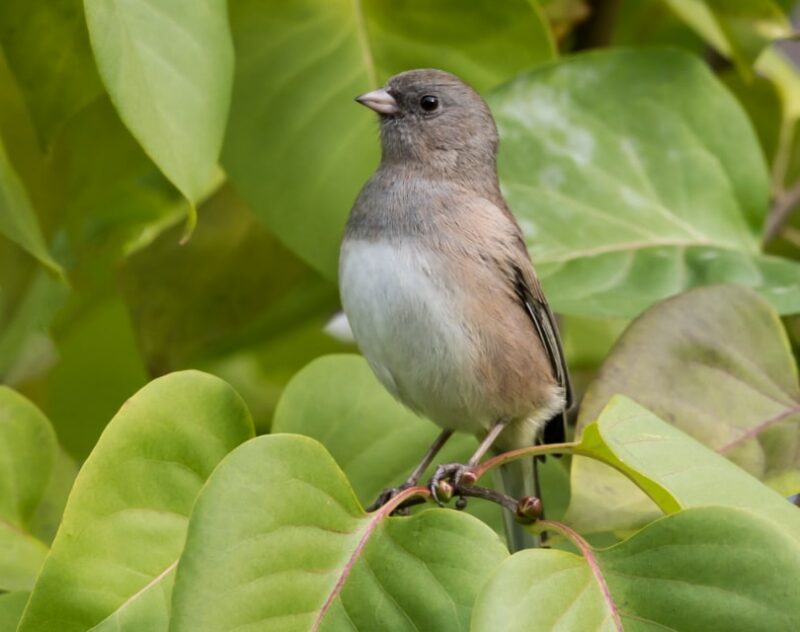
Sparrows are a common type of bird, but there are so many kinds of species that fall under this family. Illinois is home to over 25 species of sparrows. Some are year-round residents, while others will head south for the winter or visit during migration season.
It can take some time to distinguish the different kinds of sparrows in Illinois, but most can be identified by their unique calls and songs. Our list of common types of sparrows in Illinois will help you get to know each one and give you ideas for finding them.

The 26 Most Common Types of Sparrows in Illinois
1. Horned Lark
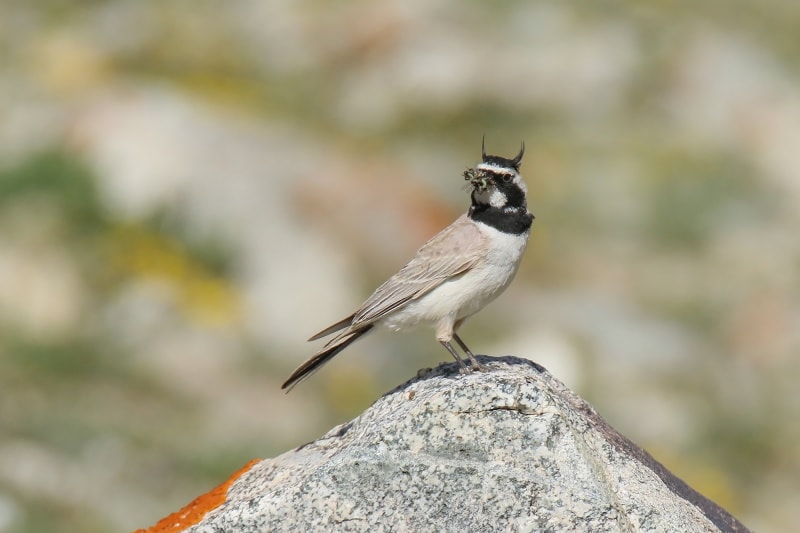
| Scientific Name: | Eremophila alpestris |
| Distinct Markings: | Black mask, horn-shaped head feathers |
| Year-round Sightings: | Yes |
Horned Larks are unique because they’re one of the only sparrows with horn-shaped feathers on their head. So, they’re easy for birdwatchers to identify. However, only males have these feathers, while females have flat heads and mottled plumage.
Horned Larks live in large fields and will forage for insects and seeds. These birds are extremely social and live in large flocks during the breeding season. They have very musical calls, and males will sing while perching and also when in flight.
2. House Sparrow
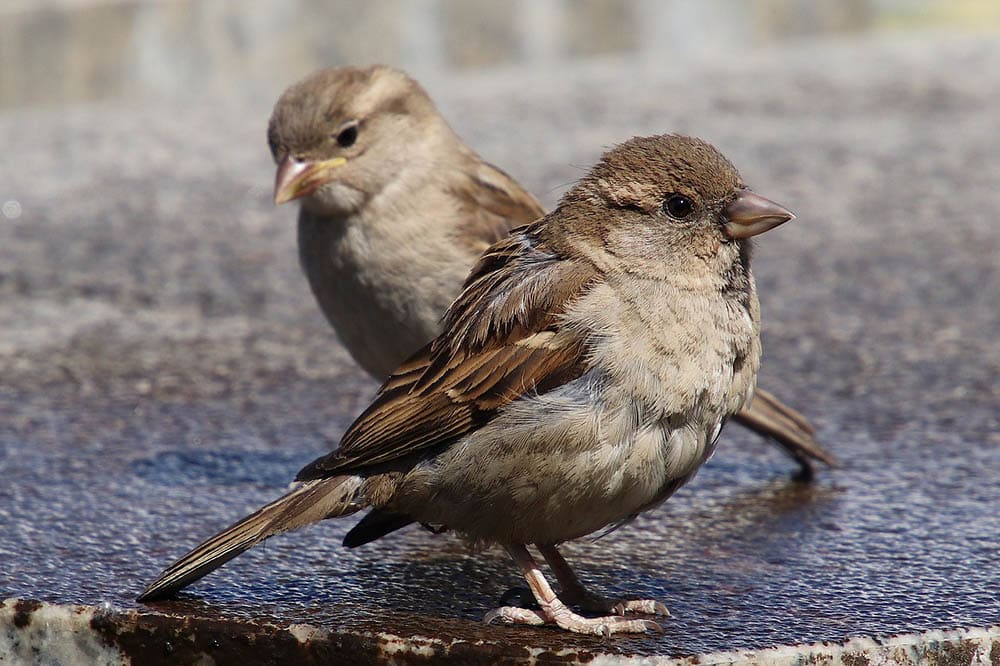
| Scientific Name: | Passer domesticus |
| Distinct Markings: | Speckled bib, black streaks |
| Year-round Sightings: | Yes |
House Sparrows are one of the most common types of sparrows you will see in Illinois. They are not native to North America and are actually an invasive species originating from the Middle East.
You do not have to go far to find a House Sparrow. These birds are extremely hardy and adaptable and can live in suburban and urban areas. These birds love grains and can often be seen picking popcorn kernels and pieces of bread off the ground at amusement parks, fairs, and other event grounds.
3. Song Sparrow
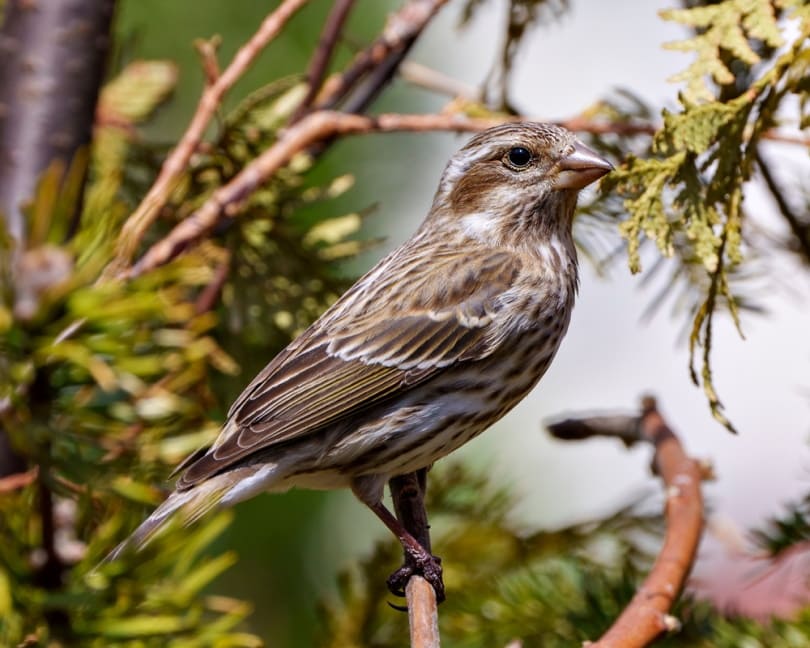
| Scientific Name: | Melospiza melodia |
| Distinct Markings: | Brown streaks on head |
| Year-round Sightings: | Yes |
Song Sparrows are another common species in Illinois, but they can be difficult to identify because they look similar to a lot of other sparrows. Song Sparrows prefer to live in open areas with plenty of shrubs. They also like grassy and weedy wetlands.
Song Sparrows got their name from their beautiful calls. They can hit a few notes and have a pleasant trill. Song Sparrows live all across North America, and they’ll have varying songs depending on their location.
4. Swamp Sparrow
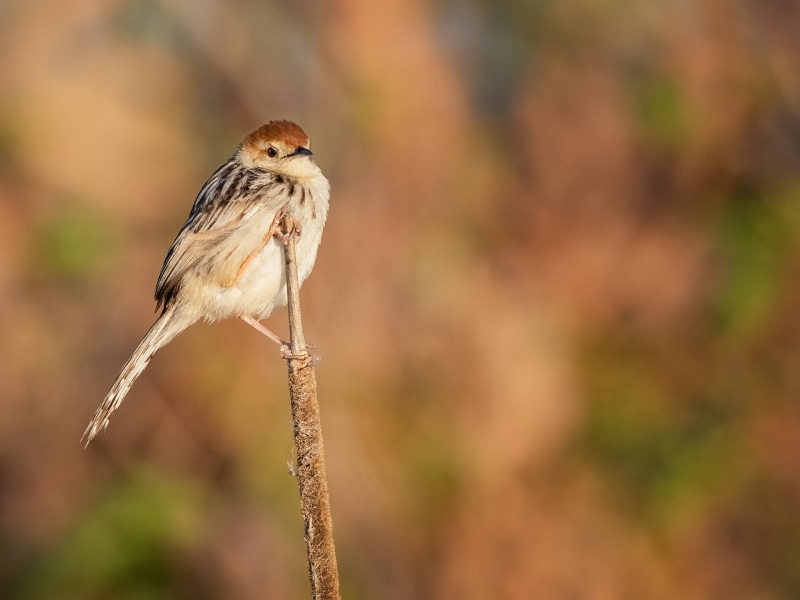
| Scientific Name: | Melospiza georgiana |
| Distinct Markings: | Red caps, brown streak behind eyes |
| Year-round Sightings: | Yes, in Northern Illinois |
Swamp Sparrows have a plump and round build. You’ll find them near bodies of water, and they like to hide beneath tall grasses and reeds. The best place to find them is near the edge of a pond or lake where they’ll be hunting for insects or foraging for seeds.
Despite having a round body, they have relatively long legs that enable them to walk along shallow water to hunt. Males may even perch on cattails and trill a few notes.
5. Vesper Sparrow

| Scientific Name: | Pooecetes gramineus |
| Distinct Markings: | White eye-ring, striped feathers |
| Year-round Sightings: | No |
Vesper Sparrows are the only members of the Pooecetes genus. They live in meadows, prairies, and other grassy areas. They prefer drylands over wetlands and will spend much of their time on the ground foraging for seeds. You can also find them dustbathing on open grounds.
These sparrows have a beautiful song that they sing in the summer. Once the seasons change, they’ll start to migrate south and winter in the southern states and Central America.
6. White-Crowned Sparrow
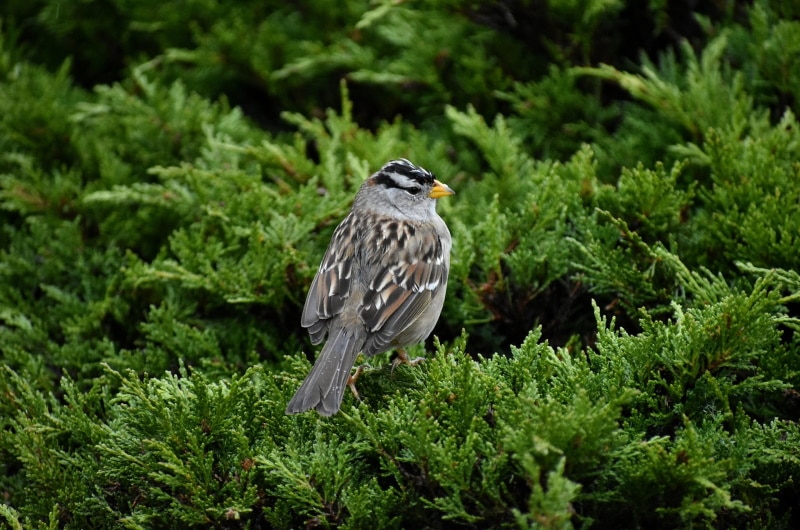
| Scientific Name: | Zonotrichia leucophrys |
| Distinct Markings: | Black and white stripes on head, peaked crown feathers |
| Year-round Sightings: | No |
The White-Crowned Sparrow is easily identified by its black and white striped head and bright yellow-orange bill. Some White-Crowned Sparrows have pink hues on their bills. These sparrows can be found in open grasslands, weedy fields, and thickets. They love eating seeds and many people have had success attracting them with sunflowers in their birdfeeders.
While these birds like foraging on the ground, they’re excellent flyers and can travel for hundreds of miles in one night during migration season.
7. White-Throated Sparrow

| Scientific Name: | Zonotrichia albicollis |
| Distinct Markings: | Black and white streaks on head, yellow spot between eyes |
| Year-round Sightings: | No |
White-Throated Sparrows have a unique yellow spot next to each eye. They’re easy to identify because of their black and white stripes running along their heads. You’ll have the best luck finding these sparrows along forest edges. They like to stay on the ground to forage.
You can also try to attract these birds in the wintertime with bird feeders. They may even choose to stay for a while if you place brush piles and shelter nearby.
8. Savannah Sparrow
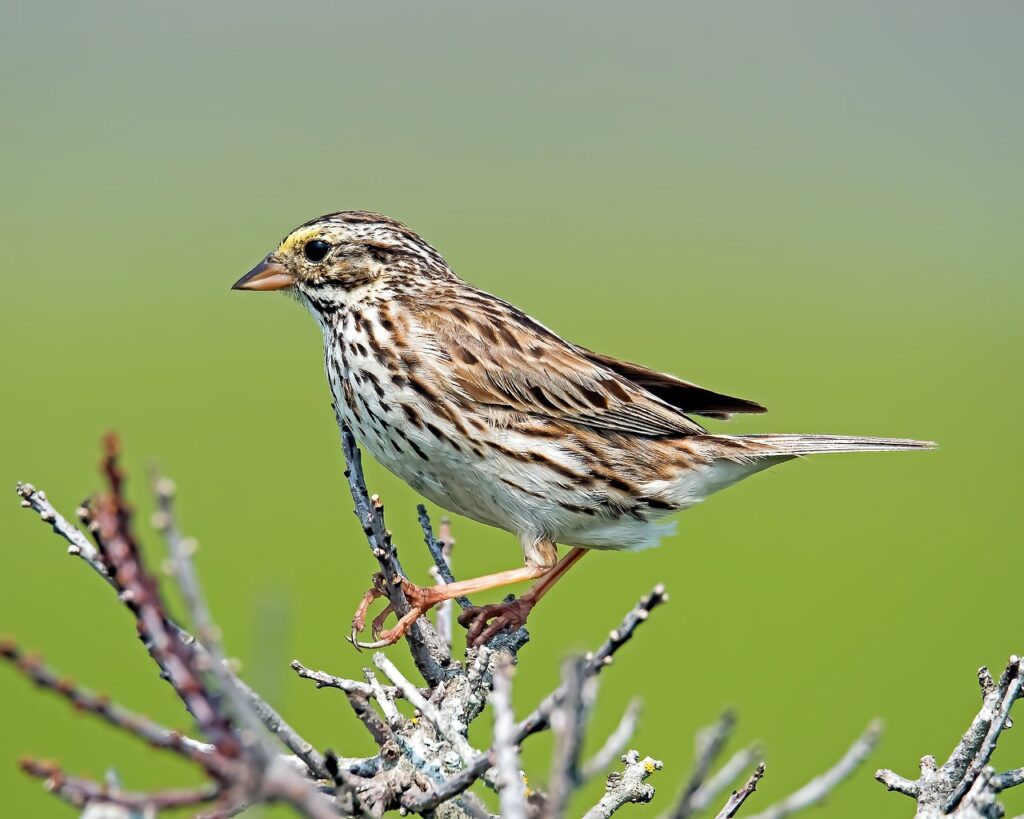
| Scientific Name: | Passerculus sandwichensis |
| Distinct Markings: | Yellow marking by eye |
| Year-round Sightings: | No |
Savannah Sparrows can be found all throughout Illinois. They like living in dense grasslands and fields, but they can also be found along grassy roadsides. Despite being widespread in Illinois, they can be a bit challenging to find. They’re not known to visit bird feeders, and you’ll have to be deliberate in searching for them in their natural habitats.
You’ll have the most luck searching the ground for foraging Savannah Sparrows. Males may perch on a fence to sing. Their song has a mix of high notes, buzzes, and trills.
9. Lincoln’s Sparrow

| Scientific Name: | Melospiza lincolnii |
| Distinct Markings: | Brown, gray, and black streaks on head |
| Year-round Sightings: | No |
Lincoln’s Sparrows are medium-sized sparrows that migrate through Illinois. They live in wetlands and meadows in the summer and will move to wooded areas and tropical forests for the winter.
These sparrows are very musical and aren’t known to sing in flight. So, if you hear their tune, there’s a good chance that you’ll be able to spot them on a nearby perch.
10. Snow Bunting

| Scientific Name: | Plectrophenax nivalis |
| Distinct Markings: | White chest, brown facial markings |
| Year-round Sightings: | No |
Snow Buntings are one of the more unique-looking sparrows you’ll find in Illinois. Their feathers are mostly white, and they have darker backsides and brown markings on their faces. As their name states, Snow Buntings prefer living in colder climates and will breed in high altitudes and nest along rocky crags.
These sparrows are committed parents as females will never leave their nest once they’ve laid eggs. Males will go out and hunt and forage for food and feed their mates all throughout the day.
11. Lapland Longspur

| Scientific Name: | Calcarius lapponicus |
| Distinct Markings: | Red nape feathers, yellow bill |
| Year-round Sightings: | No |
Lapland Longspurs can be found all throughout Illinois, but they prefer living in colder climates. The appearance of males and females is very distinct from each other. Females are brown and tan, while males have black and white heads and red napes.
Male Lapland Longspurs are talented singers who will fly at impressive heights and sing simultaneously to attract mates. They will also present piles of grass and moss to females.
12. Dark-Eyed Junco
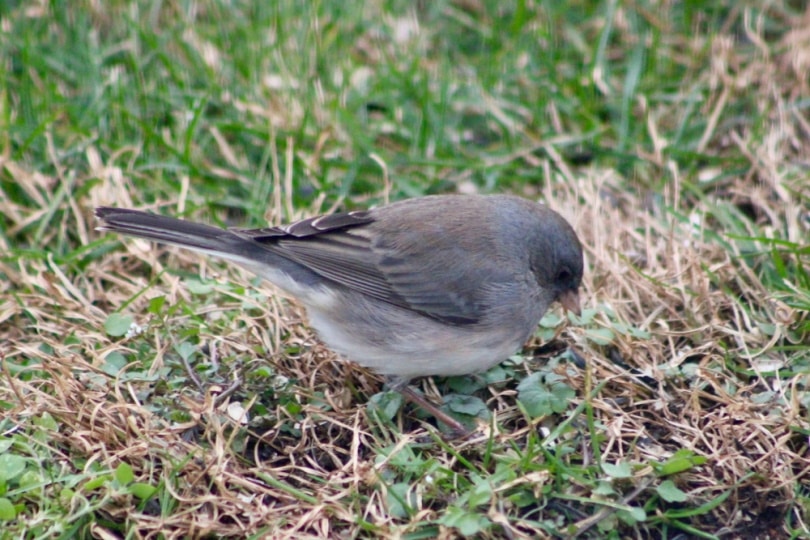
| Scientific Name: | Junco hyemalis |
| Distinct Markings: | Solid black and gray feathers |
| Year-round Sightings: | No |
Dark-Eyed Juncos look very different from what people usually think sparrows look like. They have charcoal gray feathers and white underbellies. These sparrows are one of the most common species of sparrows that fly through Illinois and are easy to find.
Their natural habitats include coniferous forests and dense woodlands, but they can also be found in backyards and parks. They’ll visit bird feeders but will forage on the ground. So, if you want to see these birds in the winter, make sure to scatter seeds on the ground for them to pick up.
13. Chipping Sparrow
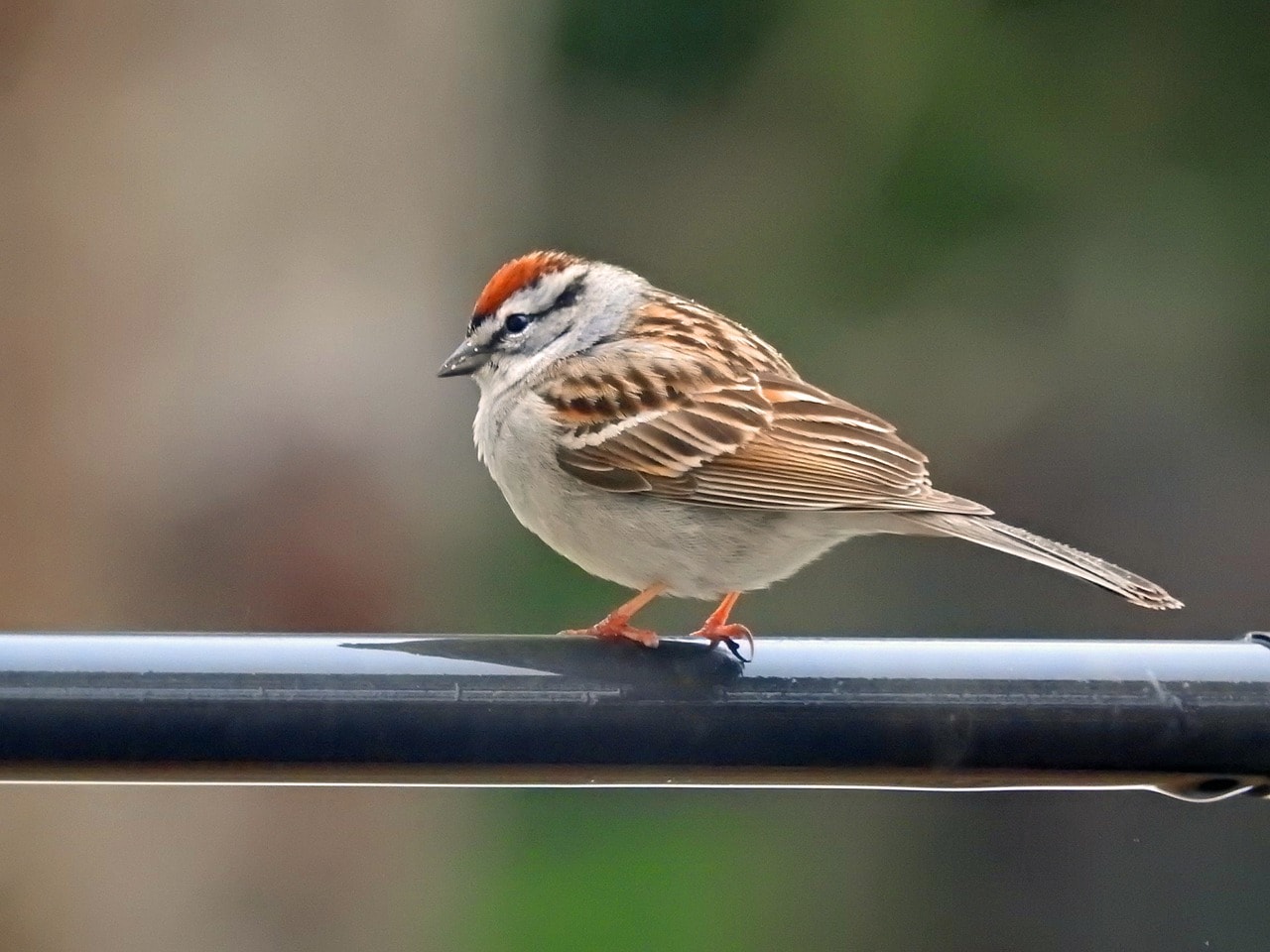
| Scientific Name: | Spizella passerina |
| Distinct Markings: | Thick bills, speckled breast feathers |
| Year-round Sightings: | No |
Chipping Sparrows are commonly found in Illinois and can be identified by their red caps and black streaks that run across their eyes. These birds naturally live in woods and meadows, but they’re very adaptable and can be found in suburban neighborhoods as well. They’ll also be frequent backyard visitors if you have a bird feeder set up in a quiet area.
Chipping Sparrows have a loud call. They have a distinct, long trill that’s most often heard in the springtime.
14. Fox Sparrow
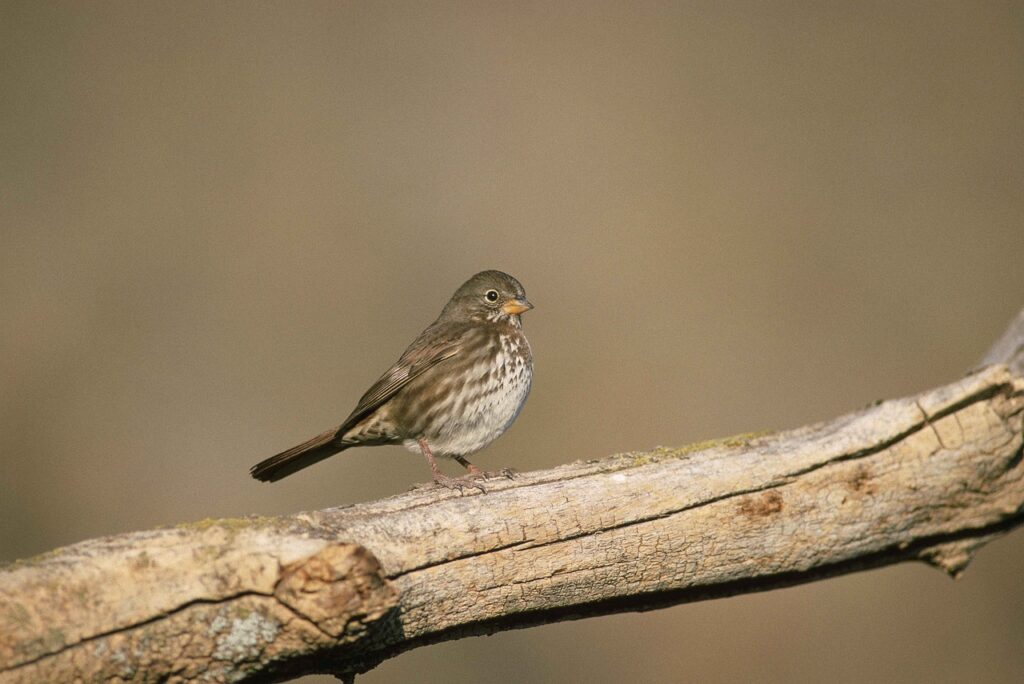
| Scientific Name: | Passerella iliaca |
| Distinct Markings: | Males have black mask and horn-shaped head feathers |
| Year-round Sightings: | No |
The traditional appearance of a Fox Sparrow is red and rusty colorings and markings that are similar to foxes. However, their colorings will vary by location.
These birds tend to dwell in forests until wintertime and can be found in shrublands during the breeding season. They’ll also visit backyards, and the best way to attract them is to scatter small seeds on the ground for them to forage. Both males and females sing, and you can identify them by their whistles.
15. Grasshopper Sparrow

| Scientific Name: | Ammodramus savannarum |
| Distinct Markings: | Flat head, orange marking above eye |
| Year-round Sightings: | No |
Grasshopper Sparrows have flat heads, long beaks, and short tails. These birds are excellent runners and hoppers and spend much of their time in fields hunting for grasshoppers and other insects. These birds will nest on the ground, so it’s important to be mindful of their nests when walking in fields during the breeding season.
These birds are unique songbirds and have two types of songs that are very different from each other. They’ll either buzz or let out a high-pitched squeak.
16. American Pipit

| Scientific Name: | Anthus rubescens |
| Distinct Markings: | Narrow bill, streaks on the underside |
| Year-round Sightings: | No |
American Pipits prefer to nest in tundras and alpine meadows. When they’re wintering, they can be found near bodies of water and rivers or open grasslands. They have long hind toes that help them stay balanced on unstable grounds as they search for insects. These birds can be identified by the way they walk and strut like a chicken.
Male American Pipits are extremely territorial and can be found competing for nesting grounds during the breeding season. Females can also be aggressive when nesting and are known to chase away intruders.
17. American Tree Sparrow

| Scientific Name: | Spizelloides arborea |
| Distinct Markings: | Brown crowns, yellow lower bill |
| Year-round Sightings: | No |
American Tree Sparrows are common backyard visitors in the wintertime. So, you’ll most likely see them if you scatter small seeds and millet in your backyard. These birds have large appetites despite their small size and need to eat at least and drink at least 30% of their body weight each day.
Male American Tree Sparrows have beautiful songs that are mixed with clear notes and trills. These sparrows live in small flocks, and you can often find them hopping around and foraging for seeds in weedy fields, marshes, and forest edges.
18. Clay-Colored Sparrow

| Scientific Name: | Spizella pallida |
| Distinct Markings: | Stripes on face, streaky feathers |
| Year-round Sightings: | No |
Clay-colored Sparrows are tiny sparrows with a slender build. They’re foragers and can be found in shrublands and prairie thickets. Some may also live in coniferous forests.
Young Clay-Colored Sparrows are known to leave their nests before they can fly. You can find them hopping around near their nests and hiding in bushes and thickets until they can fly. These birds are often in flocks with other species of sparrows. You can usually distinguish them by listening to the male’s distinct buzzing call.
19. Dickcissel

| Scientific Name: | Spiza americana |
| Distinct Markings: | Yellow chests, yellow face mask |
| Year-round Sightings: | No |
Dickcissels are sparrows with unique markings. They have yellow chest feathers and streaks that run across their eyes. These birds are rare to find in Illinois, but you may find some that stop in the central part of the state during the breeding season.
Dickcissels live in grassy areas and like to perch on tallgrass and eat berries. They’re also known to forage on the ground. They form extremely large flocks that can reach around 1,000 birds when they migrate. When they’re wintering, a flock can be as numerous as 1 million birds.
20. Eastern Towhee

| Scientific Name: | Pipilo erythrophthalmus |
| Distinct Markings: | Black upper body feathers, white underbody feathers |
| Year-round Sightings: | Yes, in Southern Illinois |
Eastern Towhees can be found in all regions of Illinois, but only live in the southern part of the state year-round. These sparrows have mostly solid-colored feathers. Males have a black upper body, while females have a brown upper body. Both males and females have white underbellies.
Eastern Towhees are one of the largest species of sparrows in Illinois. They prefer to find food by foraging on the ground and often live in wooded areas with thick brushes.
21. Harris’ Sparrow

| Scientific Name: | Zonotrichia querula |
| Distinct Markings: | Speckled crown, wide orange bill |
| Year-round Sightings: | No |
Harris’ Sparrows are known for the speckled crowns and bright orange bills. They’re quite rare to find in Illinois and will migrate near the western edge of the state. They only breed in Canada and live in tundras with tall pines.
You may have some luck attracting Harris’ Sparrows to your yard with a birdfeeder. They like to eat seeds and berries, and may even choose to forage or rest in piles of brush and twigs.
22. Henslow’s Sparrow

| Scientific Name: | Centronyx henslowii |
| Distinct Markings: | Green-yellow heads, striped feathers |
| Year-round Sightings: | No |
Henslow’s Sparrows can be a bit of a challenge to find. They like to hide in fields with thick brush and will migrate south and live in salt marshes. These birds are quick on their feet and often prefer running over flying, so it’s unlikely to spot them in flight or perched up on tall trees.
Another reason why they’re difficult to find is that they have very short calls. Henslow’s Sparrows emit a brief, high-pitched whistle.
23. Lark Sparrow

| Scientific Name: | Chondestes grammacus |
| Distinct Markings: | Brown streaks across head, pale underbellies |
| Year-round Sightings: | No |
Lark Sparrows are known for their unique calls. Males can buzz, trill, and sing a few notes. They’ll also put on a show when they’re mating by hopping around their potential mates and spreading their tail feathers as they dance. If a male manages to impress a female, he’ll gift her with a twig.
The best places to go birdwatching for Lark Sparrows are in open woodlands and orchards. They can also be found in some grasslands located near woods.
24. LeConte’s Sparrow

| Scientific Name: | Ammonspiza leconteii |
| Distinct Markings: | Yellow-orange feathers, black streak around eyes |
| Year-round Sightings: | No |
LeConte’s Sparrow is one of the smallest species of sparrows in North America. These birds have bright and beautiful shades of yellow on their faces, large, flat heads, and short wings.
Despite having brighter plumage than most other sparrows, these LeConte’s Sparrows are actually quite difficult to find. They prefer to hop around and hide in tall grasses rather than fly because they’re not the strongest fliers. They’re excellent at hiding in bushes, so it can be challenging to spot these birds.
25. Nelson’s Sparrow

| Scientific Name: | Ammonspiza nelsoni |
| Distinct Markings: | Brown eye masks, conical bill |
| Year-round Sightings: | No |
Up until 1998, Nelson’s Sparrows were lumped with Saltmarsh Sparrows until scientists identified them as two distinct species. Nelson’s Sparrows prefer living in wetlands and marshes with tall reeds, and they’ll migrate to the southern states in the winter and live in saltwater marshes. They tend to eat insects rather than fruits or seeds.
It’s difficult to hear their call as it’s very short and can sound like hissing. Male Nelson’s Sparrows aren’t known to be territorial, but they often stop singing when another male approaches their vicinity.
26. Smith’s Longspur

| Scientific Name: | Eremophila alpestris |
| Distinct Markings: | Black and white stripes on face, notched tail |
| Year-round Sightings: | No |
Smith’s Longspurs are rarely seen in Illinois and migrate through the central and southern regions of the state. Their diet consists of insects and seeds, and they’ve developed a habit of dislodging an insect’s limbs before eating it.
The best places to spot Smith’s Longspurs are in wet grasslands in the summertime. They’ll eventually migrate to the south as the weather gets colder. You can also identify these birds by their short and scratchy call.

Final Thoughts
Illinois is home to so many different types of sparrows. Most sparrows prefer foraging on the ground, so if you’d like to see more of them, try scattering seeds and berries on the grass in your yard rather than hanging a bird feeder.
Many types of sparrows are open to visiting backyards, especially during the wintertime, so they’ll appreciate any food that’s laid out for them and won’t be shy about eating their fill.
Featured Image Credit: FotoRequest, Shutterstock
Table of Contents
- The 26 Most Common Types of Sparrows in Illinois
- 1. Horned Lark
- 2. House Sparrow
- 3. Song Sparrow
- 4. Swamp Sparrow
- 5. Vesper Sparrow
- 6. White-Crowned Sparrow
- 7. White-Throated Sparrow
- 8. Savannah Sparrow
- 9. Lincoln’s Sparrow
- 10. Snow Bunting
- 11. Lapland Longspur
- 12. Dark-Eyed Junco
- 13. Chipping Sparrow
- 14. Fox Sparrow
- 15. Grasshopper Sparrow
- 16. American Pipit
- 17. American Tree Sparrow
- 18. Clay-Colored Sparrow
- 19. Dickcissel
- 20. Eastern Towhee
- 21. Harris’ Sparrow
- 22. Henslow’s Sparrow
- 23. Lark Sparrow
- 24. LeConte’s Sparrow
- 25. Nelson’s Sparrow
- 26. Smith’s Longspur
- Final Thoughts
About the Author Jessica Kim
Jessica is a freelance writer who spends most of her day researching and writing a number of topics. She loves sharing helpful information that people can use to better understand their pets, nature and the world around them. When she isn't writing, you may find her walking dogs, tending to her plant babies, or drinking her nth cup of coffee.
Related Articles:
Monocular vs Telescope: Differences Explained (With Pictures)
10 Types of Hummingbirds in Arkansas (With Pictures)
8 Types of Hummingbirds in Nebraska (With Pictures)
5 Types of Hummingbirds in Idaho (With Pictures)
3 Types of Hummingbirds in Mississippi (With Pictures)
8 Types of Hummingbirds in Kansas (With Pictures)
5 Types of Hummingbirds in West Virginia (With Pictures)
5 Types of Hummingbirds in Ohio (With Pictures)
